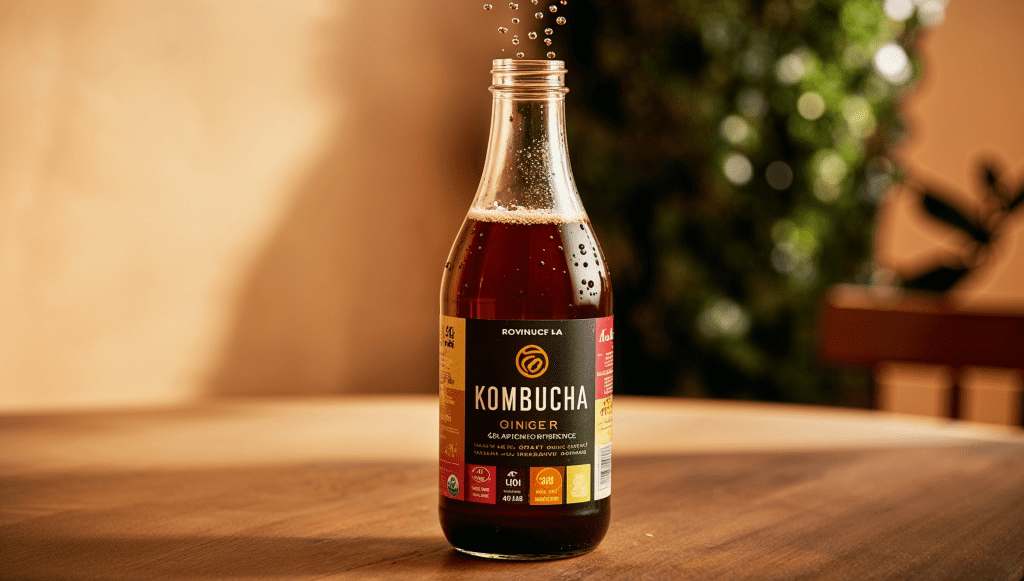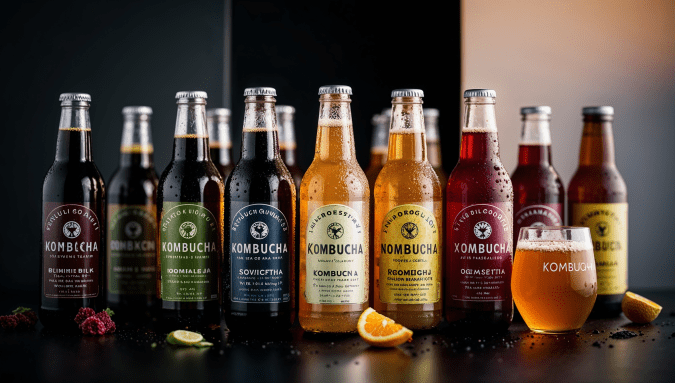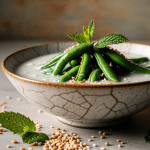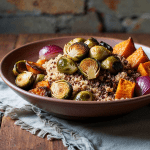This recipe will guide you through making your own vegetarian kombucha at home. Kombucha is a fermented tea drink that is slightly effervescent and packed with probiotics.
Ingredients
- For the SCOBY:
- 7 cups filtered water
- ½ cup white sugar (100g)
- 4 bags black tea (or 1 tablespoon loose-leaf tea)
- 1 cup unflavored, unpasteurized store-bought kombucha (as a starter)
- For the First Fermentation:
- 14 cups filtered water
- 1 cup white sugar (200g)
- 8 bags black or green tea (or 2 tablespoons loose-leaf tea)
- 2 cups unflavored kombucha (from a previous batch or store-bought)
- 1 SCOBY
Instructions
Make the SCOBY:
- Bring 7 cups of water to a boil in a clean pot.
- Remove from heat and add the tea bags. Let steep for about 15 minutes.
- Remove the tea bags and stir in the sugar until dissolved.
- Allow the sweetened tea to cool to room temperature.
- Pour the cooled tea into a large glass jar and add the unpasteurized kombucha.
- Cover with a clean cloth secured with a rubber band and let it sit in a warm, dark place for about 1 to 4 weeks until a SCOBY forms.
Prepare for First Fermentation:
- Once your SCOBY is ready, bring another 14 cups of water to a boil.
- Remove from heat and add the tea bags, letting them steep for about 15 minutes.
- Remove the tea bags and stir in 1 cup of sugar until fully dissolved. Allow this sweetened tea to cool to room temperature.
Combine Ingredients:
- Pour the cooled sweetened tea into a large glass jar.
- Add the previously prepared kombucha (2 cups) and gently place the SCOBY on top.
- Cover the jar with a clean cloth secured with a rubber band.
First Fermentation:
- Let the mixture ferment at room temperature for about 7 to 14 days, depending on your taste preference. Taste it periodically starting at day 7; it should be slightly sweet and tangy.
Bottling and Second Fermentation (Optional):
- Once your kombucha has reached your desired flavor, remove the SCOBY and set it aside in some of the kombucha liquid for future use.
- Pour the kombucha into bottles, leaving some space at the top. You can add flavorings at this stage, such as fresh fruit, herbs, or spices.
- Seal the bottles tightly and leave them at room temperature for an additional 3-7 days to carbonate.
Refrigerate:
- After carbonation, transfer your bottles to the refrigerator to stop fermentation. Your homemade vegetarian kombucha is now ready to enjoy!
Tips
- Flavor Variations: Experiment with different fruits like berries, ginger, or citrus during bottling for unique flavors.
- Monitor Fermentation: Keep an eye on your kombucha during fermentation; warmer temperatures will speed up the process.
- SCOBY Care: Store any extra SCOBYs in some kombucha liquid in a jar in the fridge if you’re not brewing regularly.

Benefits of Drinking Homemade Kombucha
Drinking homemade kombucha offers several health benefits, primarily attributed to its rich content of probiotics, antioxidants, and organic acids. Here are some key advantages:
- Rich in Probiotics: Kombucha contains live bacteria that help maintain a balanced gut microbiome, enhancing digestion and absorbing nutrients efficiently.
- Digestive Enzymes: The drink contains digestive enzymes that assist in breaking down food into smaller, more absorbable components, maximizing nutrient absorption.
- Source of Antioxidants: Kombucha is rich in antioxidants derived from the tea used in its preparation. These antioxidants help neutralize harmful free radicals, reducing oxidative stress and contributing to overall health and well-being.
- Immune Support: Supporting a balanced gut microbiome indirectly enhances the body’s immune response, aiding in fighting off infections and maintaining overall immunity.
- Detoxification Aid: Glucuronic acid present in kombucha helps bind to toxins, facilitating their elimination from the body, thereby supporting liver function and overall health.
- Heart Health: Polyphenols contained within kombucha may help reduce inflammation and lower the risk of certain chronic diseases, including heart conditions.
- Boost Mental Health: The gut-brain axis suggests that a healthy gut microbiome supported by kombucha probiotics can positively impact brain health, potentially reducing symptoms of depression and anxiety.
How Long Does It Take for the SCOBY to Form in a New Batch?
The formation of a SCOBY (Symbiotic Culture of Bacteria and Yeast) in a new batch of kombucha typically takes anywhere from 7 to 28 days. Factors influencing this timeframe include temperature, cleanliness, and the initial strength of the starter culture. Generally, it starts to appear within 7–10 days, but patience is required as it may take up to three weeks for a visible SCOBY to form.
Can I Add Probiotics to My Homemade Kombucha?
While it’s technically possible to add external probiotics to your kombucha, it’s generally not recommended. The primary purpose of using a SCOBY is to cultivate specific beneficial microbes naturally during fermentation. Introducing external probiotics might disrupt the natural balance established by the SCOBY and could potentially contaminate the brew with unwanted organisms. Therefore, relying solely on the SCOBY-provided probiotics is advisable.
Common Mistakes to Avoid When Making Kombucha
- Contamination Risk: Ensure all equipment is sterilized and handled hygienically to minimize contamination risks.
- Incorrect Temperature: Maintain consistent warmth (between 68°F and 85°F) for proper fermentation.
- Insufficient Sugar: Adequate sugar is necessary for feeding the SCOBY; insufficient amounts can impede fermentation.
- Poor Handling Practices: Handle the SCOBY gently and avoid exposing it to direct sunlight or extreme temperatures.
- Ignoring Secondary Fermentation: Allowing secondary fermentation can enhance flavor and carbonation but requires careful monitoring to avoid over-carbonation.
How Does Fermentation Time Affect the Taste of Kombucha?
The length of fermentation significantly affects the taste of kombucha:
- Short Fermentation Times (~7 Days): Results in a sweeter, less tangy flavor.
- Medium Fermentation Times (~10-14 Days): Balances sweetness and tanginess, producing a typical kombucha flavor.
- Long Fermentation Times (>14 Days): Leads to a stronger, more sour taste due to increased acidity from prolonged fermentation.
Monitoring fermentation times closely ensures achieving your preferred level of tanginess and overall flavor profile.
Enjoy your homemade vegetarian kombucha as a refreshing drink packed with probiotics!












